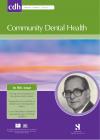Community Dental Health

- Cover Date:
- June 2011
- Print ISSN:
- 0265 539X
- Vol:
- 28
- Issue:
- 2
Geographical accessibility to dental care in the Japanese elderly
Objective: The current research aims to clarify the factors relevant to elderly people’s access to dental care in Japan, particularly focusing on geographical accessibility. Methods: The sample was taken from among the Japanese elderly, aged 65 and over, who responded to a postal survey conducted in 2003 (n = 2,192). Six types of geographical accessibility to the dental clinics were calculated using Geographic Information Systems. Logistic regression analysis was conducted using ‘having a regular dentist’ as a dependent variable and geographical accessibility as an explanatory variable. Results: The results showed an association between having a regular dentist and geographical accessibility only for females. In the univariate model, distance to the closest dental clinics (OR=0.62 (95%CI: 0.43-0.90)), number of dental clinics at the school district level (OR=1.14 (95%CI: 1.03-1.26)), number of dental clinics at the municipality level (OR=1.02 (95%CI: 1.00-1.05)), and density distribution of dental clinics (OR=1.56 (95%CI: 1.11-2.19)) showed significant relations with having a regular dentist. After controlling for demographic, socioeconomic, and health related variables, only the density distribution of dental clinics showed significant relations at the 5% level, although distance and number of dental clinics kept a marginal significance. Conclusion: The current study verifies that geographical accessibility correlates with access to dental care among women, and that there were large gender differences concerning the issue of geographical access.
Key words: Access to care, geographical accessibility, GIS, Japan, oral health.
- Article Price
- £15.00
- Institution Article Price
- £
- Page Start
- 128
- Page End
- 135
- Authors
- T. Hanibuchi, J. Aida, M. Nakade, H. Hirai, K. Kondo
Articles from this issue
- Title
- Pg. Start
- Pg. End
- Socioeconomic inequality in self-reported oral health status: The experience of Thailand after implementation of the Universal Coverage policy
- 136
- 142
- Relationship between dental anxiety, general anxiety level and depression in patients attending a university hospital dental clinic in Turkey.
- 149
- 153
- Relationship between bone fragility of the mandibular inferior cortex and tooth loss related to periodontal disease in older people
- 165
- 169
- The Relationship between Self-Reported Oral Health, Self-Regulation, Proactive Coping, Procrastination and Proactive Attitude
- 170
- 173
- Is there a correlation between dental caries and body mass index-for-age among adolescents in Iran?
- 174
- 177
- Nigerian dentists’ knowledge of the current guidelines for preventing infective endocarditis
- 178
- 181
